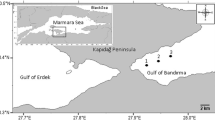Abstract
The diversity and species richness of total meiofauna, Harpacticoida and Oligochaeta in relation to depth and other environmental variables were studied at nine stations and in two profundal depth zones in Lake Päijänne which includes both oligotrophic and eutrophicated or organically loaded areas.
Diversity was on average higher in the upper part of the profundal zone than at maximum depths. This may show that the greater temporal stability in temperature at greater depths does not surpass the effect of the lower temporal stability in oxygen content. The productivity factor may be a more important reason for the bathymetric difference in diversity than the stability factor. Diversity in the lower profundal zone shows a negative correlation with variables indicating pollution while in the upper profundal zone a positive one with those variables, thus emphasizing the importance of the production factor in determining diversity in the upper profundal. Diversity was higher within the oligochaetes than within the harpacticoids, which may imply that oligochaetes have a longer evolutionary history as part of the lacustrine benthic system.
Of the environmental variables, phytoplankton biomass had the highest influence on total diversity in the lower profundal zone, oxygen being next in importance. The sedimentation of organic matter was most important in the upper part of the profundal zone, where oxygen did not have any significant effect on diversity. Some explaining factors determining bathymetric diversity differences are discussed in relation to the theoretical expectations.
Similar content being viewed by others
References
Bazzanti, M. and M. Seminara, 1987. Profundal macrobenthos in a polluted lake. Depth distribution and its relationship with biological indices for water quality assessment. Acta Oecol. Oecol. Applic. 8 (1): 15–226.
Begon, M., J. L. Harper and C. R. Townsend, 1990. Ecology. Individuals, populations and communities, 2nd ed., Blackwell Scientific Publications, Boston, 945 pp.
Brown, J. H., 1988. Species diversity. In: Myers, A. A. and P. S. Giller, Analytical Biogeography. An integrated approach to the study of animal and plant distributions. Chapman and Hall, London, New York, pp. 57–89.
Connell, J.H., 1978. Diversity in tropical rainforests and coral reefs. Science 199: 1302–1310.
Fenchel, T.M., 1978. The ecology of micro- and meiobenthos. Ann. Rev. Ecol. Syst. 9: 99–121.
Grassle, J.F., 1989. Species diversity in deep-sea communities. TREE 4: 12–15.
Guhl, W., 1987. Aquatic ecosystem characterizations by biotic indices. Int. Revue ges. Hydrobiol. 72: 431–455.
Hurlbert, S.H., 1971. The nonconcept of species diversity: a critique and alternative parameters. Ecology 52: 577–586.
Jakher, G.R., 1986. Species diversity of macrobenthic fauna in a tropical lake. Comp. Physiol. Ecol. 11: 217–225.
Kolasa, J., 1984. Does stress increase ecosystem diversity? Nature 309: 118.
Krebs, C.J., 1978. Ecology. The experimental analysis of distribution and abundance, 2nd ed., Harper and Row, New York, 678 pp.
Maatela, P., J. Paasivirta, J. Särkkä, and R. Paukku, 1990. Organic chlorine compounds in lake sediments. II. Organically bound chlorine. Chemosphere 21: 1343–1354.
Margalef, R., 1958. Temporal succession and spatial heterogeneity in natural phytoplankton. In: E. Buzzati-Traverso (ed.), Perspectives in marine biology, Univ. California Press, Berkeley, pp. 323–349.
Menge, B. A. and J.P. Sutherland, 1976. Species diversity gradients: synthesis of the roles of predation, competition, and temporal heterogeneity. Amer. Nat. 110: 351–369.
Paasivirta, J., H. Hakala, J. Knuutinen, T. Otollinen, J. Särkkä, L. Welling, R. Paukku and R. Lammi, 1990. Organic chlorine compounds in lake sediments. III. Chlorohydrocarbons, free and chemically bound chlorophenols. Chemosphere 21: 1355–1370.
Pielou, E. C., 1975. Ecological diversity, Wiley, New York, 165 pp.
Ruggiu, D. and C. Saraceni, 1972. A statistical study of the distribution and abundance of the bottom fauna of a lake undergoing accelerated eutrophication (Lake Mergozzo, N. Italy). Mem. Ist. Ital. Idrobiol. 29: 169–187.
Särkkä, J., 1972. The bottom macrofauna of the oligotrophic Lake Konnevesi, Finland. Ann. Zool. Fennici 9: 141–146.
Särkkä, J., 1975. Effects of pollution on the profundal meiofauna of Lake Päijänne, Finland. Aqua Fennica 1975: 3–11.
Särkkä, J., 1979. The zoobenthos of Lake Päijänne and its relations to some environmental factors. Acta Zool. Fennica 160: 1–46.
Särkkä, J., 1982. A quantitative ecological investigation of the littoral zoobenthos of an oligotrophic Finnish lake. Ann Zool. Fennici 20: 157–178.
Särkkä, J., 1987. Meiobenthos of the profundal depths of Lake Päijänne. Biol. Res. Rep. Univ. Jyväskylä 10: 95–104.
Särkkä, J., 1989. Meiobenthic naidid and aeolosomatid oligochaetes from the profundal zone, and relations of species to eutrophication. Hydrobiologia 180: 185–190.
Särkkä, J., 1992. Effects of eutrophication and organic loading on the occurrence of profundal harpacticoids in a lake in southern Finland. Environ. Monit. Assessment 16: 211–223.
Thiel, H., 1966. Quantitative Untersuchungen über die Meiofauna des Tiefseebodens. Veroff. Inst. Meeresforsch. Bremerhaven, Sonderb. 2: 131–147.
Warwick, R. M., 1988. The level of taxonomic discrimination required to detect pollution effects on marine benthic communities. Marine Pollut. Bull. 19: 259–268.
Author information
Authors and Affiliations
Rights and permissions
About this article
Cite this article
Särkkä, J. Diversity of meiofauna in the lacustrine profundal zone: Bathymetric differences and influence of environmental factors. Aquatic Science 55, 197–205 (1993). https://doi.org/10.1007/BF00877449
Received:
Accepted:
Issue Date:
DOI: https://doi.org/10.1007/BF00877449




